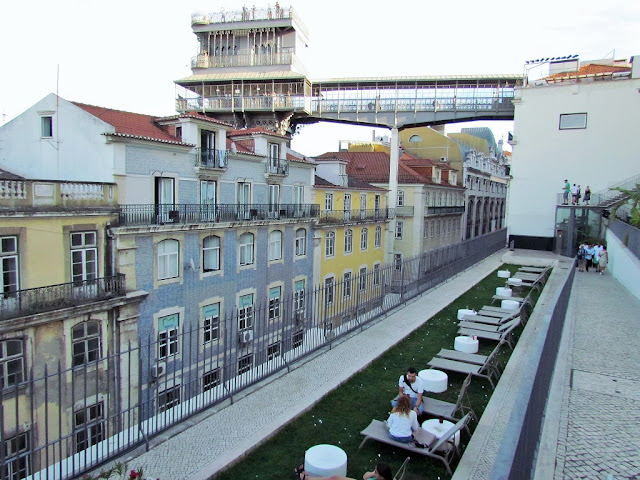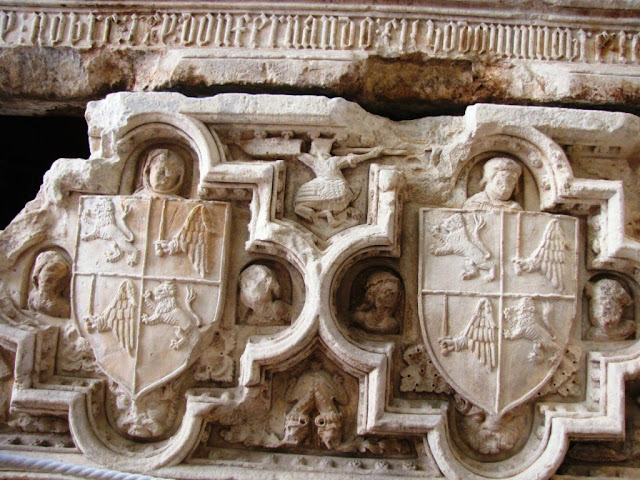 |
| LISBON - DOWNTOWN |
RUA DO CARMO
There are trendy shops of international brands and some other traditional and very old ones.
Famous little glove store ‘Luvaria Ulisses’, Rua do Carmo nr 87 A
This very small shop has its own production of tailor made gloves from any design. A real tourist attraction.
The beautiful decorated shop ‘Au Bonheur des Dames‘.
(Joalharia) Jewelry do Carmo, Rua does Carmo 87B, is one of the best shops in the city. All the silver pieces are handmade, it’s really worth a visit.
 |
| LISBON- RUA DO CARMO»»RUA GARRET»» CALÇADA DO SACRAMENTO»»LARGO DO CARMO»» SANTA JUSTA LIFT |

RUA GARRET
This shopping street is not very long, yet it's where most of Lisbon seems to gather whenever they go out.
It's the center of the lively Chiado district, home to the city's most popular cafés and shops, as well as Armazéns do Chiado (FNAC, McDonald's), a former department store that is now a small shopping mall.
No supermarket inside this shopping center. Supermarkets: Rua 1º de Dezembro ( Pingo Doce ), Praça da Figueira ( Mercado da Figueira ), Rua Barata Salgueiro / Rua de Santa Marta ( Minipreço );
Rua de São Paulo, just beside the church; Calçada do Combro ( Minipreço ), just beside the upper
entrance of Funicular of Bica; Largo do Mastro ( Campo dos Martires da Pátria - Pingo Doce );
Rua da Palma ( Minipreço )
CALÇADA DO SACRAMENTO
It's the center of the lively Chiado district, home to the city's most popular cafés and shops, as well as Armazéns do Chiado (FNAC, McDonald's), a former department store that is now a small shopping mall.
No supermarket inside this shopping center. Supermarkets: Rua 1º de Dezembro ( Pingo Doce ), Praça da Figueira ( Mercado da Figueira ), Rua Barata Salgueiro / Rua de Santa Marta ( Minipreço );
Rua de São Paulo, just beside the church; Calçada do Combro ( Minipreço ), just beside the upper
entrance of Funicular of Bica; Largo do Mastro ( Campo dos Martires da Pátria - Pingo Doce );
Rua da Palma ( Minipreço )
CHURCH OF BLESSED SACRAMENT
( IGREJA DO SANTÍSSIMO SACRAMENTO )
Calçada do Sacramento has a length of 0.1 kilometers.
BLESSED SACRAMENT CHURCH - A 18th-century baroque interior and ceiling paintings.
Wonderful Largo do Carmo, located close to the heart of the legendary Bairro Alto district, in Chiado, is one of my favorite squares in Lisbon: the beautiful trees, the historical buildings, the atmosphere, the fascinating church ruins, the extraordinary Santa Justa elevator, and the amazing city views!
Largo do Carmo and blossoming jacarandas (trees):
Originally from South America, these beautiful trees of the Bignoniaceae family arrived in Lisbon in the mid-17th century, and ever since, between May and June when they’re in flower, they have lovely bunches of lilac-toned petals.
1
SANTA JUSTA LIFT
( ELEVADOR DE SANTA JUSTA )
On the top floor panoramic views of the city, while connections to the floors below are made (in addition to the elevator) by two spiral staircases, with different patterns on each story. The main machinery was installed at the base of the Elevator, while at the exit to the Largo do Carmo there is a veranda to allow circulation. The corridor that passes above the structure, was transformed into a terrace, and exits to Largo do Carmo through an iron gate. The space destined for the electrical equipment was located under the Escadinhas, in a space set aside for this purpose, under a vaulted ceiling.
The Lift is decorated in a Neo-Gothic style in iron. Since this was a new material at the time of its construction, it is symbolic of the technical and memorial construction from this period, representing the culture of the 1900s, when the structure and elevators were considered a magical innovation and portent of a modern age.
.JPG) |
| You are not in danger. There are policemen disguised as seagulls. |
TERRAÇOS DO CARMO
If you want to go up the Santa Justa Elevator, avoid the lines on Rua de Santa Justa and access it through here.
2
CARMO CONVENT ( ARCHAEOLOGICAL MUSEUM OF CARMO )
Here you can also find an entrance to the famous Archeological Museum, the gothic ruins of the 14th century Chuch of Carmo Convent (Igreja do Convento do Carmo).
The medieval convent was ruined in the 1755 Lisbon Earthquake, and the ruins of its Gothic church (the Carmo Church or Igreja do Carmo) are the main trace of the great earthquake still visible in the city. The Carmo Convent is located in the Chiado neighborhood, on a hill overlooking the Rossio square and facing the Lisbon Castle hill. It is located in front of a quiet square (Carmo Square), very close to the Santa Justa Lift. Nowadays the ruined Carmo Church is used as an archaeological museum (the Museu Arqueológico do Carmo or Carmo Archaeological Museum). The Carmo Convent and its Church were built between 1389 and 1423 in the plain Gothic style typical for the mendicant religious orders. There are also influences from the Monastery of Batalha, which had been founded by King John I and was being built at that same time. Compared to the other Gothic churches of the city, the Carmo Church was said to be the most imposing in its architecture and decoration. The church has a Latin cross floorplan. The main facade has a portal with several archivolts and capitals decorated with vegetal and anthropomorphic motifs. The rose window over the portal is partially destroyed. The south side of the church is reinforced by five flying buttresses, added in 1399 after the south wall collapsed during the construction work. The old convent, located to the right of the facade, has been rebuilt in neo-Gothic style in the early 20th century( text from incredible-pictures)
3
FOUNTAIN
A unique fountain stands under trees right in the middle of the square. The Chafariz (fountain) do Carmo was built here in 1796
4
CHURCH "NOSSA SENHORA DO MONTE DO CARMO"
5
"FERNANDO PESSOA" HOUSE
Nr 18 first floor
In this house, the immortal poet lived four years, (1908-1912)
6
GNR ( NATIONAL GARD )- FUTURE MUSEUM
The headquarters of Carmo (Quartel do Carmo) is a very important building for Portugal’s history. Marcelo Caetano (former dictator António de Oliveira Salazar’s replacer) found refuge in the main Lisbon military police station at the time of the revolution. On April 25, 1974, the day of the carnation Revolution, this building was surrounded by the MFA (Portuguese Armed Forces), which pressured Marcelo Caetano to cede power to general Spínola. It was here where the Estado Novo (New Regime) officially came to an end after almost 50 years.
The Carnation Revolution (Revolução dos Cravos) was a largely bloodless coup. Remarkable: there were two secret signals in the military coup: first the airing of the song “E Depois do Adeus” (“And after the farewell”) by Paulo de Carvalho, Portugal’s entry in the 6th of April 1974 Eurovision Song Contest, which alerted the rebel captains and soldiers to begin the coup. Next, on April 25, 1974, at 12:15 am, the national radio broadcast Grândola, Vila Morena, a song by Zeca Afonso, a progressive folk singer forbidden on Portuguese radio at the time. This was the signal that the MFA gave to take over strategic points of power in the country and “announced” that the revolution had started.

























-B.JPG)
-C.JPG)
-D.JPG)
-E.JPG)
F.JPG)




.JPG)
.JPG)
.jpg)








.JPG)
.JPG)
.jpg)
.jpg)
.jpg)
.jpg)
.jpg)
.jpg)





-A.JPG)
-B.jpg)
-E.jpg)
-F.JPG)
-H.JPG)
-I.jpg)
-J.jpg)
-L.jpg)
-M.jpg)
-N.JPG)
-C.JPG)
-D.JPG)
-K+-+C%C3%B3pia.JPG)
-L.JPG)
.JPG)
.JPG)
.JPG)
-A.JPG)
-B.jpg)
.JPG)
.JPG)







.JPG)
.JPG)
.JPG)
.JPG)
.JPG)



























-C.JPG)
-D.JPG)
-A.JPG)
-B.jpg)
-C.JPG)
-D.JPG)
-E.JPG)
.JPG)
.JPG)
.JPG)
.JPG)
.JPG)
.JPG)
.JPG)
.JPG)
.JPG)
.JPG)
.JPG)
-B.JPG)
.jpg)
.jpg)













































































































.JPG)
.JPG)
.JPG)
.JPG)
.JPG)
.JPG)
.JPG)
.JPG)
.JPG)
.JPG)
.JPG)
.JPG)
.JPG)
.JPG)
.JPG)
.JPG)
.JPG)
.JPG)
.JPG)
.JPG)
.JPG)
.JPG)
.JPG)
.JPG)
.JPG)
.JPG)
.JPG)
.JPG)
.JPG)
.JPG)
.JPG)
.JPG)